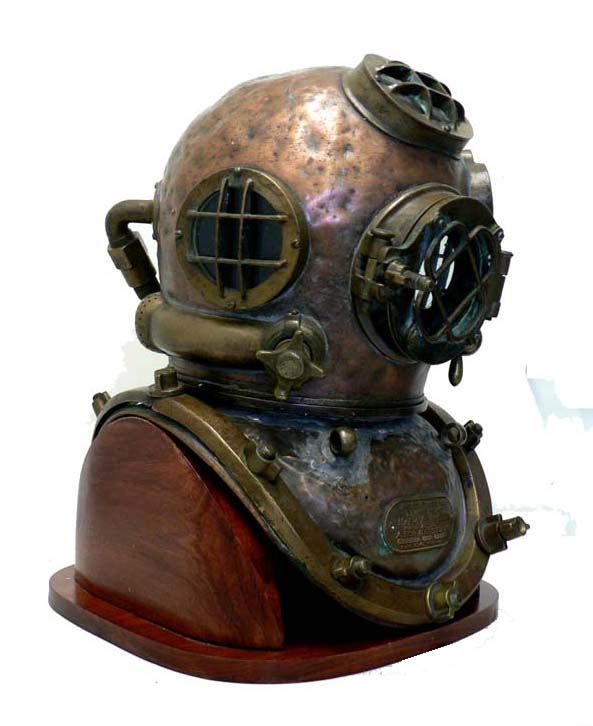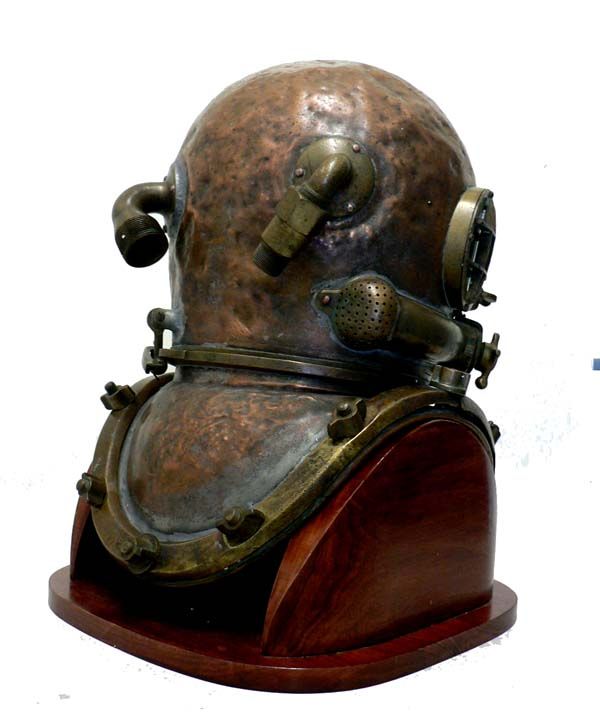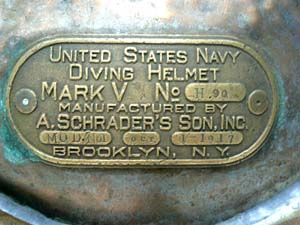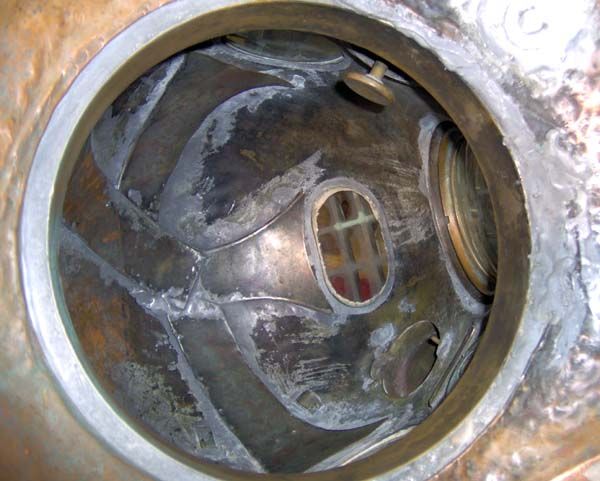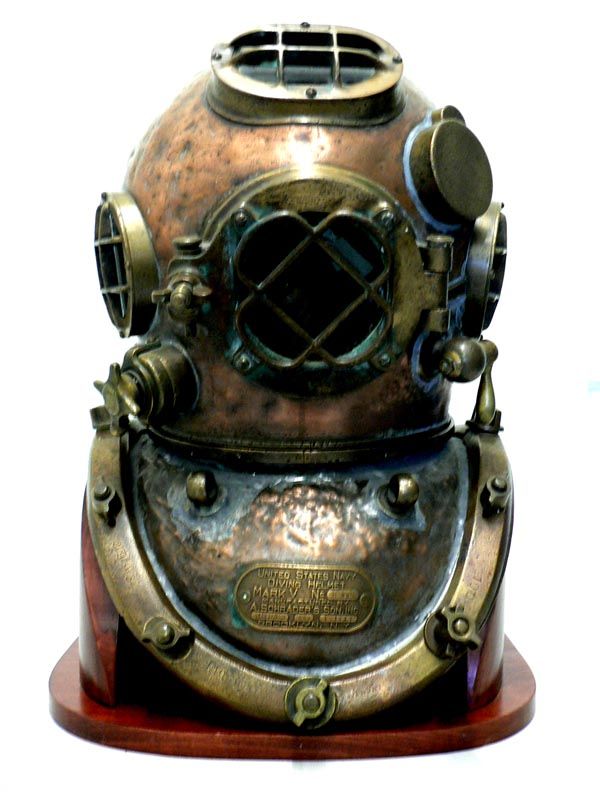
Presented is one of the very first mil-spec MK V helmets made for the U.S. Navy.
It is an authentic 12 bolt, 4 light Schrader Navy MK V dated October 1, 1917 with matching assembly number 100 on its
neck ring and brailes. It is all original and has numerous small dents and dimples over its breast plate and bonnet, acquired
over its 90 years of age. Note the second wing nut on thebastard thread. The
helmet comes from a collection where it was for the last twelve years, and prior
to that it was part of another collection.
HISTORY OF SCHRADER DIVING: Schrader is one of the oldest names in U.S. diving,
second only to Morse. The founder, August Schrader was a creative and inventive German immigrant who originally set
up a shop dealing in rubber products in New York City, NY in 1839, only a few years after A.J. Morse set up shop in Boston.
In 1845 he began supplying fittings and valves for rubber products made by the Goodyear Brothers.
115
Schrader was also a maker of daguerreotype apparatus. His original shop was at
John Streetin Manhattan, NY.
Shortly thereafter he went into partnership with Christian Baecher. Christian was a brass turner and finisher which provided
a foundation for what followed.
The two partners, having watched divers at work at a nearby New York Harbor jetty, decided
to improve the diving helmets in use at the time. In 1849, with the help of Baecher, he created a new copper helmet. Later
his interest in diving led to him to design an air pump.
Around 1890, August Schrader saw the need for a bicycle tire valve. By 1891, he produced the Schrader
valve. The Schrader valve was his most popular invention, and is still used today.
In 1916, the United States Bureau of Construction & Repair introduced the MK V helmet and dress,
which then became the standard for US Navy diving until the introduction of the MK 12 in the late nineteen seventies. Schrader
and Morse Diving were the two original suppliers.
During the onslaught of World War Two only Morse and Schrader were making dive helmets for
the navy. Desco and Miller-Dunn went into production around 1943. In total only about 7,000 MK V helmets were produced by
all four companies during the war years with DESCO producing the most, then Morse, Schrader and Miller-Dunn. The scarcity
of the latter two are the reason they command a higher price in the market.
CONDITION and MARKINGS: This helmet
is left in essentially the condition it was used in its last dive and preserves
its character and history. It is being offered as a display item only, and should not be used for any other purpose unless
certified by a competent diving shop.
The number 100 appears on the top of each braile (strap), and the lower ring
of the helmet. All the air passages inside are intact.The right side chin relief valve, spit cock handle, front door wing
nut, all turn easily. There is no telephone receiver and the cotter pin for the dumb bell lock is missing. The check valve
has the Schrader imprint.
The rectangular shaped brass name plate has serial number H-90 and OCT-10-17 stamped on. The
combined weight of the chest plate and bonnet is 52 pounds.
Vents Intact
BRIEF HISTORY of NAVY MK V DEEP SEA DIVING DRESS:By 1915, George Stillson of the Bureau of Construction and Repair had designed the MK V Diving
Helmet which seemed to address many of the problems encountered in diving. This deep-sea outfit was designed for extensive,
rugged diving work and provided the diver maximum physical protection and some maneuverability.The 1915 MK V Diving Helmet had an elbow inlet with a safety valve that allowed air to enter
the helmet, but not to escape back up the umbilical if the air supply were interrupted. Air was expelled from the helmet through
an exhaust valve on the right side, below the port. The exhaust valve was vented toward the rear of the helmet to prevent
escaping bubbles from interfering with the diver’s field of vision.By 1916, the first year of production, several improvements had been made to the
helmet, including a rudimentary communications system via a telephone cable and a regulating valve operated by an interior
push button. The regulating valve allowed some control of the atmospheric pressure. A supplementary relief valve, known as
the spitcock, was added to the left side of the helmet. A safety catch was also incorporated to keep the helmet attached to
the breast plate. The exhaust valve and the communications system were improved by 1927, and the weight of the helmet was
decreased to be more comfortable for the diver.After 1927, the MK V changed very little. It remained basically the same helmet used in salvage
operations of the USS S-51 and USS S-4 in the mid-1920s. With its associated deep-sea dress and umbilical, the MK V was used
for all submarine rescue and salvage work undertaken in peacetime and practically all salvage work undertaken during World
War II. The MK V Diving Helmet was the standard U.S. Navy diving equipment until succeeded by the MK 12 Surface-Supplied Diving
In February 1980 the MK 12 was replaced by the MK 21 in December 1993.
